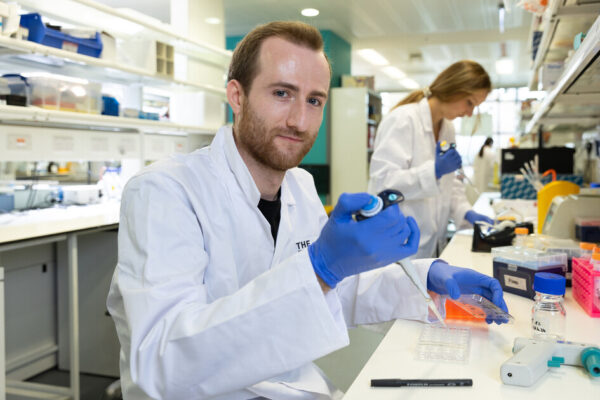Our condition-specific alert cards provide crucial information for emergency healthcare professionals treating patients with muscle wasting conditions.
Congenital muscular dystrophies (CMD)
Congenital muscular dystrophies (CMD) are a group of inherited conditions that are usually present at birth or become apparent in the first few months of life. In some babies, initial symptoms can be subtle and go unnoticed, and the diagnosis may not be made until infancy or childhood.
Babies with CMD often have low muscle tone (hypotonia), which may make them feel ‘floppy’ when held or picked up. Infants with CMD are likely to be delayed in reaching motor milestones, such as sitting and walking.
There are many different subtypes of CMD. We have specific information on the following subtypes:
- Bethlem myopathy
- LAMA2-related congenital muscular dystrophy
- LMNA-related congenital muscular dystrophy
- SELENON-related myopathy (previously known as SEPN1-related myopathy and rigid spine muscular dystrophy)
- Ullrich congenital muscular dystrophy
The signs, symptoms, and severity, of CMD vary significantly – depending on the genetic subtype.
Symptoms of CMD can include:
- Low muscle tone and floppiness (hypotonia)
- Muscle weakness starting soon after birth or in childhood
- Delayed motor milestones such as sitting unaided and walking
- Joint tightness (contractures) in the ankles, hips, knees, and elbows
- Breathing problems caused by weakness in the respiratory muscles
- Heart problems
- Feeding difficulties
- Learning difficulties
- Seizures or other neurological symptoms
- Problems with vision
Muscle power in the legs and arms may be stable in early childhood, and some children may appear to gain strength in the first decade of life. However, in many CMD subtypes, muscle weakness will progress over time. Weakness of respiratory muscles may lead to breathing problems. In some subtypes of CMD, the person can still have severe respiratory weakness, even if muscle weakness is mild.
Each type of CMD can vary greatly in severity, which can make it difficult to predict future outcomes based only on the diagnosis and subtype. Some children will walk, but sometimes this can be delayed until the age of five or older. Leg splints can be used to help with walking. Some children who learnt to walk independently may lose this ability later because their muscles are unable to cope with the increased strain as they grow taller and heavier. Others may not be able to walk at all and will need to use a wheelchair. It’s important not to assume children with CMD will not reach certain motor milestones. Instead, they should be treated as an individual and supported by a team to achieve goals suited to their physical abilities, cognition, and learning.
In some subtypes of CMD, the brain can be affected, which may cause learning difficulties. If this happens, it is usually evident in the first years of life and does not usually get worse over time. Some types of CMD are also linked to differences in brain structure. When present, these differences can sometimes cause epilepsy, as well as affect learning, movement, or development. However, not all children with CMD will experience these issues. If concerns arise, doctors can assess and provide the right support.
Genetic changes
Congenital muscular dystrophies are a varied group of conditions. They happen because of changes in certain genes. Researchers have found over 35 genes linked to CMD. These genes contain instructions to make proteins that keep muscles strong and working well. Sometimes these genes also have a role in the brain. When there is a significant change in these genes, the proteins they make are faulty or too few. This leads to muscle weakness and the other associated symptoms.
The most common types of CMD in the UK are LAMA2-related CMD, and COL6 gene related dystrophies, including Ullrich CMD and Bethlem myopathy. There are many other less common subtypes. In some rare subtypes of CMD, the gene responsible hasn’t been identified, so the genetic cause is unknown. As genetic technology and testing improves and becomes more widely available, it’s hoped that the genes causing these conditions will be found.
Inheritance
The inheritance pattern of CMD depends on the subtype. In some subtypes, CMD is inherited in an autosomal dominant pattern, meaning a person only needs to inherit one changed gene from either parent to develop the condition. In other subtypes, it’s inherited in an autosomal recessive pattern, meaning both copies of the gene (one from each parent) must be changed for the condition to occur. Sometimes, there may be no family history of CMD.
For more information, see our inheritance and genetics page.
A person with CMD is usually first diagnosed as a ‘floppy’ or ‘weak’ baby. Doctors can see some of the symptoms described above, but as these could be features of many different conditions, they must carry out a series of tests to make an accurate diagnosis.
This may include:
- Blood test to measure creatine kinase (CK) levels
- Electromyography (EMG) to measure electrical activity in the muscles
- Brain and/or muscle magnetic resonance imaging (MRI)
- Muscle biopsy, where a small muscle sample is taken and examined under a microscope
- Genetic testing
Genetic testing is now the most decisive test to diagnose CMD and can help to identify the specific subtype. Other tests, like a muscle biopsy, can support the process by showing differences in muscle fibre size, areas where muscle has been replaced by fat or fibrous tissue, and changes in the amount or location of certain proteins.
For more information, see our diagnosis page.
Whilst there is no cure for CMD, treatment is holistic and focuses on the person’s function and wellbeing, as well as that of their family or carers. Care and management plans may vary depending on the subtype of CMD and how it affects the person.
It’s important to have access to a multi-disciplinary healthcare team, a team of healthcare specialists working together, who can review symptoms on a regular basis. The team should be led by a neurologist. A neurologist is a doctor who specialises in conditions that affect the muscles and nervous system. Early recognition and treatment of the complications associated with CMD – such as breathing, heart, or feeding difficulties – is important. Regular check-ups should include (but not be limited to) monitoring muscle strength, joint range, weight, feeding and swallowing function, respiratory function, and cardiac function.
Additional tests may also be needed, such as breathing tests (spirometry) to check lung function and overnight sleep studies to monitor breathing quality during sleep. In some subtypes, a yearly echocardiogram (ECHO) is needed to check the heart. If you do not have contact with a neurologist or specialist doctor, speak to your GP to get access to one.
Access to physiotherapy and orthotics services is also important. As the muscles are weak and mobility is limited, a person may be born with or develop joint contractures. Contractures are where the muscles and tendons tighten and make it difficult to move the limbs and joints freely. Hips are often affected with contractures and may sometimes be dislocated. Some types of CMD may also cause scoliosis (a curved spine), which needs specialist advice. Orthotics, such as braces or supports, can help improve joint movement and prevent deformities. Physiotherapy can also help to prevent or slow the progression of contractures, and a physiotherapist can put together a programme of suitable exercises. A physiotherapist is a healthcare professional who helps manage symptoms through movement, exercise, and manual therapy.

Author: Muscular Dystrophy UK
Reviewers: Dr Anna Sarkozy and Dr Marjorie Illingworth
Last reviewed: February 2025
Next review due: February 2028
We are here for you
Webinars, Information Days, and support groups for our muscle wasting community. Our life-changing support is here for you.
Advice for living with or caring for someone with a muscle wasting condition.


